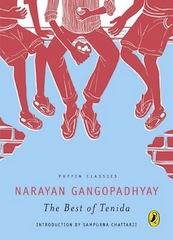

Tenida of that forty-two inch chest, standing six feet tall. You’ll never know what that means unless you’ve actually run into Tenida. He’s grown up thrashing every man alive from the soldiers on the Maidan to the rogue shopkeepers in the smuggled-goods market. If he raises his fist, you’re afraid of a punch; if he bares his teeth, you’re sure he’ll bite.
Neighbourhood bully, veteran resident of class 10 (at school he sits like a monument in Class Ten; no one can shift him an inch from his place), braggart and glutton - by no stretch of the imagination is Tenida the perfect hero. But by sheer force of will he holds together a motely crew of four friends, Pelaram Banerjee, Kyabla and Habul Sen whose adventures or rather misadventures are the subject of Puffin’s The Best of Tenida by Narayan Gangopadhyay, translated from the Bengali by Aparna Chaudhari.
The book contains one novella and five short stories and is a delightful introduction to Tenida, a popular character from YA Bengali fiction. The stories themselves range from a summer holiday mystery to tall tales in which, Tenida casts himself as the hero to neighbourhood club events – all of which are funny and quick-paced.
But the real joy of the book is in the sharply drawn characters and their interaction with each other. Bandhopayay beautifully captures the dynamics of a group of boys who might be as different as chalk and cheese but are inseparable - Pela self-pitying, cowardly and sickly; Kybla the clever one who lets Tenida think he’s calling the shots while subtly directing the events; and Hubul Sen, humble chela of the redoubtable Tenida.
Also enjoyable is the sense of time and space. Tenida’s world is steeped in the atmosphere of a Kolkata suburb in the 40s –a small neighbourhood in which teenagers unburdened by ambition or pressures of time forge the unlikeliest of friendships sitting atop the steps of each other’s homes. Yet in all of the stories are themes that resonate with Young Adult groups in school or college even today - of the clash of personalities, or unexpected moments of sympathy and many shared moments of pleasure, especially over food – from elaborate Bengali meals to a mouth-watering array of street food.
The writing dripping with wit and sarcasm has justly made Bandhopadya’s book a classic and for me also showcased what I love best about Bengali children’s writing – the writers works included stories of the contemporary world of their day and not just fables and folk tales; they did not attempt to moralize, and took their children seriously enough to create great stories for them.